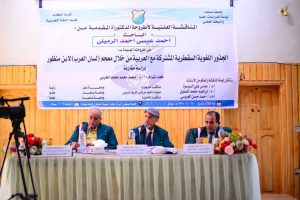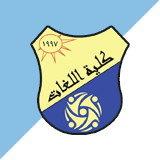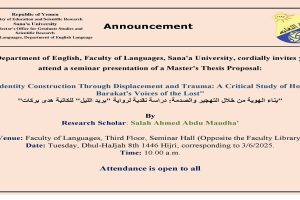Public PhD Viva-Voce Examination of Mr. Ahmad Issa Ahmad Al-Rumayli
- Posted by كلية اللغات جامعة الصنع
- Categories news
- Date December 23, 2024

The Public Viva-Voce Examination for the PhD Dissertation hereto entitled Common Socotri Linguistic Roots with Arabic in Ibn Manzur’s Dictionary (Lisanal-Arab) A Comparative Study.”, submitted by Mr. Ahmad Issa Ahmad Al-Rumayli, Department of Arabic Language, Faculty of Languages, was held on Tuesday, 16/06/1446 Hijri corresponding to 17/12/2024. The Viva-Voce Committee, which was formed based on a resolution issued by the Post-Graduate Studies and Scientific Research Council, consisted of the following:
# |
Committee Members |
Designation |
University |
Position |
1 |
Prof. Abbas Ali Al-Souswa |
External examiner |
Taiz University |
Chair |
2 |
Prof. Ibrahim Mohammed Al-Salwi |
Delegated by Main supervisor |
Sana’a University |
Member |
3 |
Assoc. Prof. Ahmed Hasan H. Al-Arousi |
Internal Examiner |
Sana’a University |
Member |
The study aimed to:
-
Identify the common linguistic roots of Socotri with Arabic through the dictionary ‘Lisan al-Arab’.
-
Discover points of agreement between Socotri and Arabic in the study of linguistic roots through ‘Lisan al-Arab’.
-
Produce serious scientific research that serves Socotri and fills a gap in the library of Semitic languages.
-
Highlight the linguistic proximity between Socotri and Arabic.
-
The research seeks to establish a dictionary of shared vocabulary between the Socotri language and Semitic languages.
-
Lay the groundwork for a dictionary that includes all roots of the Socotri language.
The study concluded with a number of findings, including
-
Socotri language falls within the Semitic language family. It is a living spoken language, the mother tongue of the inhabitants of the Socotra Archipelago, and a language, not a dialect.
-
Socotri language has a strong connection to Standard Arabic, as it is similar to it in a fair amount of vocabulary. The study counted more than (700) linguistic roots in which the two languages are similar.
-
The closest Semitic language to Socotri is Shehri; due to the great similarity in many of the vocabulary studied, and then the rest of the modern southern languages (Mahri, Hebyuti, Harsusi, Bathari), as well as South Arabic, are very close to it.
-
Socotri does not use dental sounds (ث, ذ, ظ), and it is also unique from Arabic in possessing of the lateral ش sound or the third س.
-
Both languages (Socotri and Arabic) uniquely contain some roots that have no counterparts in other Semitic languages, such as: (أ ت ب، أ د ب، أ س ل، أ ل ب، أ ل خ، أ م د، ب ج د، ب ص ص).
-
There are many words that Socotri shares with the rest of the Semitic languages, and these words are considered to be Semitic linguistic commonalities.
-
There are roots in which Socotri has expanded the meaning, while Arabic has narrowed it, such as: (أ ل خ، أ ر ب، ق ف ل).
-
There are roots in which Socotri has narrowed the meaning, while Arabic has expanded such as: (أ د ب، أ د م، ت ف ر، أ ت ب).
-
Socotri is a derivational language containing many derivations and morphological transformations (past, present, imperative, source, active participle, passive participle, diminutive…).
-
The isolation imposed by nature on Socotra has helped preserve many ancient linguistic elements and vocabulary lost in some Semitic languages, indicating the antiquity and rich heritage of the Socotri language.
The researcher made several recommendations, including
-
Establishing a comprehensive linguistic dictionary of Socotri language vocabulary.
-
Studying the Socotri language at its linguistic levels (phonetics, grammar, morphology, semantics) in comparison with Semitic languages, especially Standard Arabic and ancient Yemeni language, as well as those modern South Arabian languages that are closer to Socotri than others.
-
Creating unique phonetic symbols for the Socotri language to maintain its distinctive phonetic characteristics, as writing it with symbols from another language may lead to a loss of that uniqueness.
-
Developing a precise curriculum for teaching the Socotri language in schools to preserve it from extinction.
-
Focusing on studies that address linguistic and dialectal diversity in Yemen, encouraging and supporting researchers in this field, particularly those examining ancient Yemeni, Socotri, Mahri, Hebyuti, and various modern Yemeni dialects.
-
The necessity of documenting and recording the various Yemeni languages and their modern dialects, organizing these recordings in specialized scientific centers and modern tools for future benefit.
-
The importance of conducting scientific research in the field of historical comparative linguistics.
The PhD dissertation has been examined and is recommended by the Viva-Voce Committee for acceptance and approval. The Candidate was recommended to be awarded the degree of Doctorate in Linguistics majoring in Arabic Language.
The viva was attended by academics, researchers, students, and other interested individuals, including the researcher’s colleagues and family members.




A recorded part of the Viv-Voce session
Previous post
Public PhD Viva-Voce Examination of Ms. Abeer Abdo Hizam Sofian Al-Fawdaie
December 23, 2024



